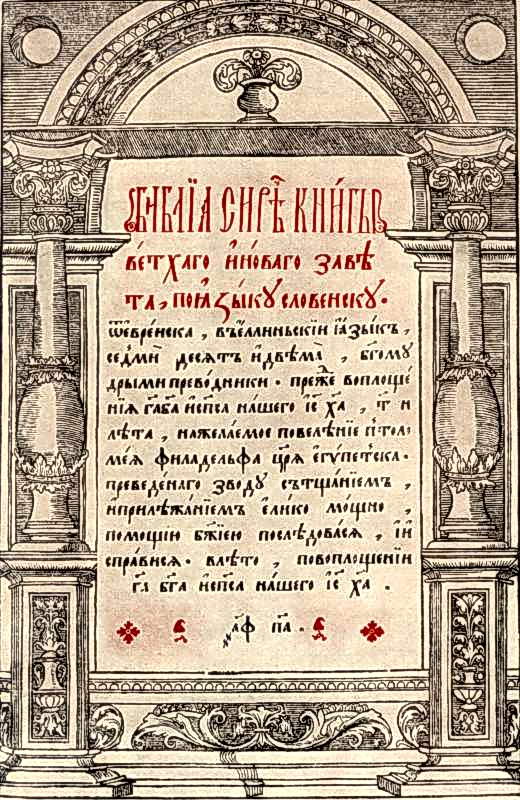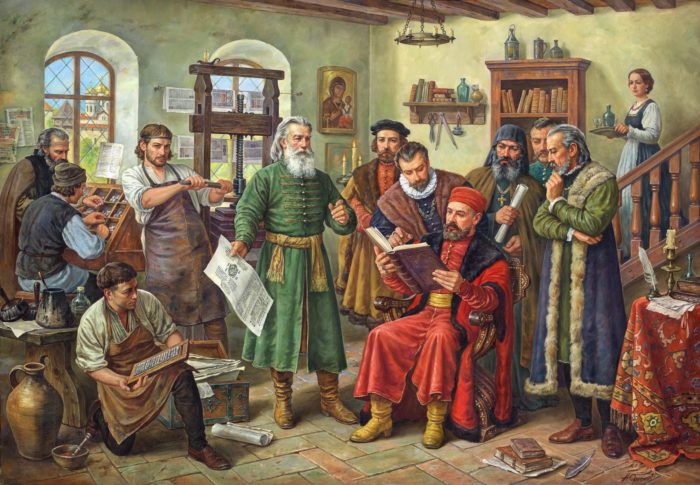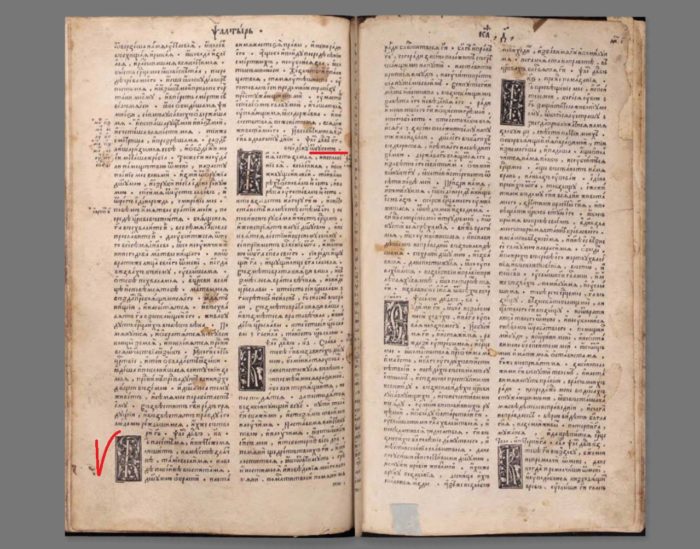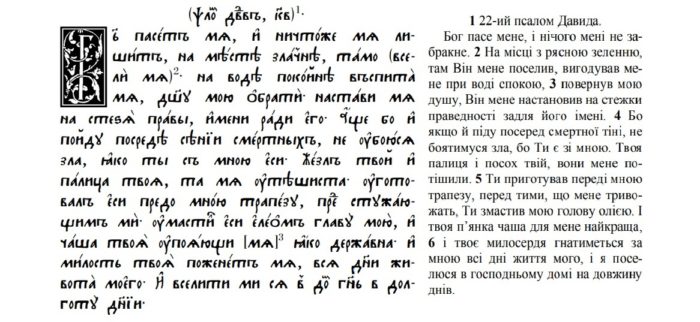Ostroh Bible
Ostroh Bible
by Iana Sotnikova

- Author: Translated by scholars of Ostroh Academy
- Title: [Ostrozka biblia] Острозка библиа (Ostroh Bible)
- Date: 1st edition 1580
- Edition: 2nd, 1581
- Printer: Ivan Fedorov
- Pages: 1256
- Language : Old Church Slavonic
- Source : Ostroh State Historical and Cultural Reserve
Purpose
Ostroh Bible (in other sources may be reffered to as Ostrog Bible), fist published 1850, is the first complete translation of the canonical biblical text into Church Slavonic. It compiles of both the New Testament and the Old Testament. The translation was made by a group of scholars at the Ostroh school (modern Ostroh Academy) and printed by the famous first printer Ivan Fedorov, by the request of the Prince Konstanty Wasyl Ostrogski. Publication of Holy Writ was an alms and a deed of honor for the Prince. He initiates this ambitious project “with trust in Lord, knowing how hard it is for the people to find salvation”.
Formal aspects
The bible has 1256 pages. It is in folio format, the text is arranged in two columns. The edition is not illuminated, but it has numerous bloomers, head and end pieces and initials, traditional for Cyrillic books. The colors used in printing are black and red. The translation was made from Greek and comprised seventy-six books of the Old and New Testaments. Generally, for the preparation of the Ostroh Bible Greek, Latin, Jewish and Western European sources, as well as other sources in Church Slavonic were used.

Value given to the edition
Ostroh Bible is an illustrious monument of Ukrainian and European culture. It was published after the appearance of Catholic and Protestant translations of the Holy Writ. The Ostroh Bible codified the Old Church Slavonic language, which became widespread in the Orthodox Slavic world. The publication of the Ostroh Bible incentivized the formation of religious and theological terminology in this language and the development of theological thought. The book printed in the end of 16th century became widespread among Orthodox Slavs, as well as among neighboring nations, such as Moldavians and Romanians. It also aroused considerable interest among representatives of other Christian denominations. Before the Ostroh Bible, the Orthodox Slavs never had the full text of the Old and New Testaments, for that matter published as one book of Holy Writ. Another remarkable aspect of the Ostroh bible is that it was printed by the famous first printer Ivan Fedorov, who was an outstanding person in Slavic book publishing, the “father” of Cyrillic typography. He started his activity in Moscow but soon was forced to move out due to the prosecution from the side of the clerical establishment and boyars. He continued his printing activities in the Polish-Lithuanian Commonwealth and worked in many cities, that are the part of the modern Ukraine territory, including Lviv and Ostroh.
Political value
An extensive preparatory work preceded the publication of the Ostroh Bible. The editors of the Ostroh Bible fulfilled an enormous task of comparison of various biblical texts, incomparable in its amount to what has ever been undertaken before at that period of time even in Western Europe. Finally it was decided to use the Septuagint as the basis of the edition. The scholars from Ostroh school, who worked on the creation of this book tried to utilize all the potential of Byzantine and old Slavic traditions, while adapting elements of Western culture, which can be considered as a form of a synthesis of Western and Eastern traditions. Despite its Orthodox orientation, the Ostroh Bible can be considered multi-religious. In the basis of its creation there are not only Orthodox texts, but also the Catholic Vulgate, Czech and Polish translations, Jewish texts etc. At the same time the aim of the Ostroh Bible publishing evidently was to strengthen the authority of the Orthodox Church, that was successfully fulfilled. The Ostroh Bible played an significant role in the strife against the Catholic Church’s attack on Orthodoxy.
Psalm 23 (22) as a specimen of Orthodox Biblical Tradition

The famous psalm 23, known in King James translation to begin by the words “Lord is my shepherd” in the Christian Orthodox texts appears under number 22. In the Ostroh Bible it is placed in two columns on the same page recto. There are no images or illustrations, accompanying this psalm, as well as the whole edition, which is typical for Christian Orthodox books. The only decorations are the bloomers in the beginning of each psalm. The text is printed with the same types as the original text. Translation into modern Ukrainian is provided in parallel.

The modern edition of 2006, published in Lviv, Ukraine the presents the full text of the Ostroh Bible of 1581. The text is printed with the same types as the original text. Translation into modern Ukrainian is provided in parallel.
Bibliography:
- Острозька Біблія та її значення для розвитку богословської думки в Україні// Релігійно-інформаційна служба України. URL: https://risu.ua/ostrozka-bibliya-ta-jiji-znachennya-dlya-rozvitku-bogoslovskoji-dumki-v-ukrajini_n84125/amp
- До 440 річчя Острозької Біблії створена її цифрова копія// Державний історико-культурний заповідник міста Острога. URL: https://ostrohcastle.com.ua/ostrozka-bibliya/
- Острозька Біблія. Ред. єрмн. архимандрит др. Рафаїл (Роман Торконяк). Львів, 2006. URL: https://volart.com.ua/art/fedoriv/1.pdf



